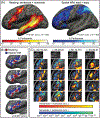Broca's Area Is Not a Natural Kind
- PMID: 32160565
- PMCID: PMC7211504
- DOI: 10.1016/j.tics.2020.01.001
Broca's Area Is Not a Natural Kind
Abstract
Theories of human cognition prominently feature 'Broca's area', which causally contributes to a myriad of mental functions. However, Broca's area is not a monolithic, multipurpose unit - it is structurally and functionally heterogeneous. Some functions engaging (subsets of) this area share neurocognitive resources, whereas others rely on separable circuits. A decade of converging evidence has now illuminated a fundamental distinction between two subregions of Broca's area that likely play computationally distinct roles in cognition: one belongs to the domain-specific 'language network', the other to the domain-general 'multiple-demand (MD) network'. Claims about Broca's area should be (re)cast in terms of these (and other, as yet undetermined) functional components, to establish a cumulative research enterprise where empirical findings can be replicated and theoretical proposals can be meaningfully compared and falsified.
Keywords: Broca’s area; LIFG; articulation; domain-specificity; executive functions; language.
Copyright © 2020 Elsevier Ltd. All rights reserved.
Figures



References
-
- Broca P (1861) Remarques Sur le Siége de la Faculté Du Langage Articulé, Suivies D’une Observation D’aphémie (Perte de la Parole). Bulletin Society Anatomique 6, 330–357.
-
- Caramazza A & Zurif EB (1976) Dissociation of algorithmic and heuristic processes in language comprehension: Evidence from aphasia. Brain Lang. 3(4), 572–582. - PubMed
-
- Hagoort P (2005) On Broca, brain, and binding: a new framework. Trends Cogn. Sci. 9(9), 416–423. - PubMed
-
- Grodzinsky Y & Santi A (2008) The battle for Broca’s region. Trends Cogn. Sci. 12(12), 474–480. - PubMed
-
- Friederici AD (2011) The Brain Basis of Language Processing: From Structure to Function. Physiol. Rev. 91, 1357–1392. - PubMed

